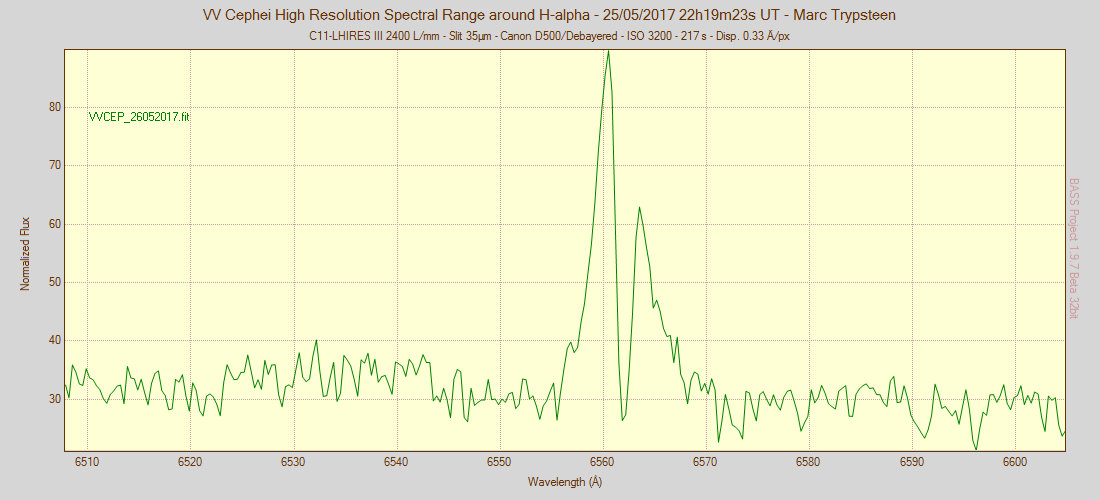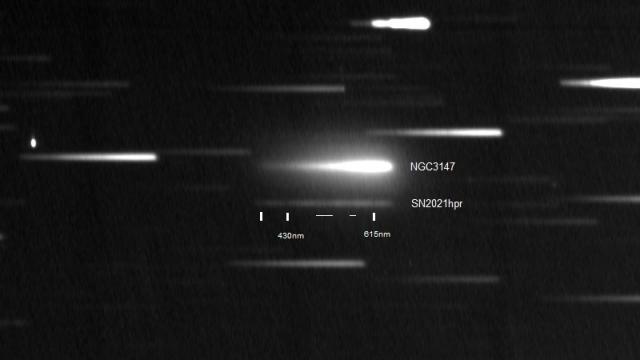› Forums › Spectroscopy › VV Cephei High Resolution
- This topic has 14 replies, 4 voices, and was last updated 8 years, 7 months ago by
 MARC TRYPSTEEN.
MARC TRYPSTEEN.
-
AuthorPosts
-
27 May 2017 at 5:57 pm #573759
 MARC TRYPSTEENParticipant
MARC TRYPSTEENParticipantHi all,
As the VV Cephei campaign focuses now on the behaviour of the binary star system in the run to the start of the upcoming eclipse high resolution (R>12000) spectra give insight in the evolution of the V/R components. In the attachment a HR spectrum is shown with focus on the Hydrogen alpha emission components (V on the left and R to the right).
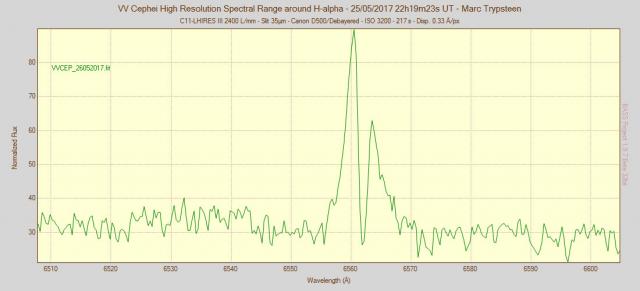
Hope the weather conditions are with us during the follow up…
Kind regards,
Marc.
27 May 2017 at 11:14 pm #578243 Robin LeadbeaterParticipant
Robin LeadbeaterParticipantHi Marc,
I’ve just noticed the times on your VV Cep spectra. Where are you observing from?
Robin
28 May 2017 at 7:39 pm #578244 Ernst PollmannParticipant
Ernst PollmannParticipantHi Marc & Robin,
the observer group (see attachment) is going to continue their HR observation of the V&R component in order to catch the moment of the beginning of its eclipse. It seems that the peak height of the V component decreases already “for some time”.
If this “effect” is true, then that does it mean, either the disk of the B star or the photospheric wind of the M star (or both) is larger than assumed until now. But we have to wait and see. In that context I am interested to get your spectrum. Would you be so friendly to send me it?
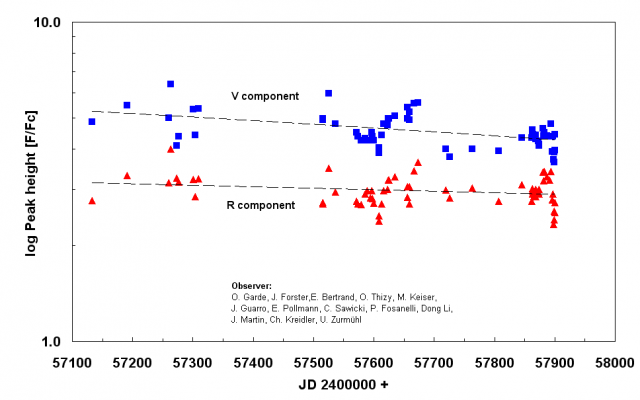
Best wishes, Ernst
28 May 2017 at 9:13 pm #578247 MARC TRYPSTEENParticipant
MARC TRYPSTEENParticipantHi Robin,
I’m observing from a location next to the “Beisbroek” forest in Bruges, Belgium, so local time here is UT+2h. Last days we had very clear nights with excellent seeing, but now the weather is changing on cloudy and rainy with thunderstorms coming over. Perhaps the second half of next week will be the next opportunity to observe. Unfortunately until mid July we must undergo the annual period of the so called “gray nights” or twilight nights. Fortunately the beginning of August will give enough dark nights to register the start of the VVCep eclipse!
Kind regards,
Marc.
28 May 2017 at 9:26 pm #578248 MARC TRYPSTEENParticipant
MARC TRYPSTEENParticipantHi Ernst,
I’m glad you mention a possible “quenching” of the V component. This was also my very first impression when I saw my first spectra. I did not have time to check the spectra I registered yesterday (27.05) to confirm this trend. Perhaps it could also be an effect of momentary pulsations which could be the precursors of the coming eclipse?
In the beginning of next week I will certainly email you my spectra. As the weather here is changing to mainly cloudy and rainy with thunderstorms I hope to register next spectra in the second half of next week as the weather will be good again. Anyway I will contribute to this project on a regular basis.
Kind regards,
Marc.
28 May 2017 at 10:48 pm #578249 Robin LeadbeaterParticipant
Robin LeadbeaterParticipantHi Marc,
But the time on your spectrum graphic is 10:19 UT. Are you observing in daylight?
Cheers
Robin
28 May 2017 at 11:16 pm #578250 Robin LeadbeaterParticipant
Robin LeadbeaterParticipantMarc wrote:
“Unfortunately until mid July we must undergo the annual period of the so called “gray nights” or twilight nights. Fortunately the beginning of August will give enough dark nights to register the start of the VVCep eclipse!”
With careful background subtraction VV Cep should be bright enough and far enough from the sun to follow at high resolution throughout the summer from where you are. For example I am further north than you (55N) and was able to follow eps Aur under much more extreme conditions.
http://www.threehillsobservatory.co.uk/astro/spectra_40.htm
Cheers
Robin
29 May 2017 at 9:22 am #578251 MARC TRYPSTEENParticipant
MARC TRYPSTEENParticipantHi Robin,
Oh sorry, AM/PM error.
Correct 24h notation implemented now. Thanks! 😉
Kind regards,
Marc.
29 May 2017 at 10:12 am #578252 MARC TRYPSTEENParticipant
MARC TRYPSTEENParticipantIndeed, Robin with a good background subtraction VV Cep will be quite doable for the H-alpha.
BTW do you intend also to register the high resolution spectra of the Fe II lines at 4233 Å ?
For that we need subtraction of a nearby M type stellar spectrum.
Kind regards,
Marc.
29 May 2017 at 1:38 pm #578253 Robin LeadbeaterParticipant
Robin LeadbeaterParticipantHi Marc,
I had not planned to specifically follow VV Cep but could contribute on an ad hoc basis. Are there any more details of the campaign? Is there any professional involvement? (Phil Bennett was mentioned as PI in a post on the ARAS forum a couple of years ago
http://www.spectro-aras.com/forum/viewtopic.php?f=19&t=1219
but the link to page given there and in the document you posted on the astronomical spectroscopy yahoo forum just leads to a blank page under construction and the rest of his pages on VV Cep linked from there are dead)
There also appears to be something odd about the dispersion figure on your graphic. At 0.33A/pixel your maximum resolving power R would be at best 10000 at H alpha, not 12000 (limited by the Nyquist sample interval) 0.33A/pixel however is much too large a figure in any case for a LHIRES III and 2400l/mm grating with the pixel size of your DSLR unless you are binning.
Cheers
Robin
29 May 2017 at 4:20 pm #578254 MARC TRYPSTEENParticipant
MARC TRYPSTEENParticipantHi Robin,
I’ll ask Ernst if a Pro-Am is foreseen or will be activated on VV Cephei.
Concerning the info links: strange those links do not work. Hope these attachments can help you.
Concerning the dispersion (the graph is a screenshot of BASS version 1.9.7) it was indicated within the BASS project software. Measurements by BASS gave for example in the red region: R= 11949@6571 Å, which was sufficient enough.
Initially without the 2x binning/zooming function the dispersion was in fact 0.17 Å/px which gives a more realistic dispersion for a LHIRES III 2400 L/mm with a slit of 35 µm and a 15 MP Canon Debayered DSLR with pixel pitch 4.69 microns.
So the original dispersion is 0.17 Å/px and the 2x zoom/binning 0.33 Å/px.
Kind regards,
Marc.
30 May 2017 at 12:48 pm #578255 Robin LeadbeaterParticipant
Robin LeadbeaterParticipantHi Marc,
I assume BASS estimates the resolution in a similar way to ISIS by estimating the FWHM of the neon calibration lines, in which case it may not give a good estimate of the resolution on undersampled spectra like this. (Not enough points in the line profile)
There is still something odd about the dispersion value. The native dispersion of the LHIRES 2400 at H alpha is ~12.8A/mm so for example giving 0.083A/pixel with my ATIK314 (6.45um pixels) Your native dispersion should be around 0.06A/pixel so it looks like there is a further 3x binning going on somewhere. In any case I suspect you are losing some resolution compared with other LHIRES III 2400 spectra of the same object. Compare for example the cleanly resolved metal/telluric lines in similar spectra on the ARAS forum as here for example.
http://www.spectro-aras.com/forum/viewtopic.php?f=19&t=362
It seems that H alpha is likely to be well covered so I might take a look in the UV. With the potential for variation in size of both the H alpha disc and the M star. It could be important to establish the extent of the M star independent of the disc. It is a more difficult area to work in but I had some success in this area with the similar but much fainter eclipse of AZ Cas
http://www.threehillsobservatory.co.uk/astro/spectra_43.htm
There is a discussion involving Phil Bennett about this area here
http://www.spectro-aras.com/forum/viewtopic.php?f=19&t=1233
Cheers
Robin
1 June 2017 at 5:29 pm #578261 Ernst PollmannParticipant
Ernst PollmannParticipantDear colleagues,
Jack Martin sent me a lot of spectra which did fill some gaps of the year 2015 and 2016 (see the attached monitoring). As we can see, the variability of the peak height of the V component becomes more and more smaller the more the moment of the eclipse is approaching.
I think that in the current phase (shortly before the eclipse and in the line of sight) the large and expanded Halpha emission-forming area (where the scattering will be produced) more and more is diving into the semi-transparent atmosphere of the M supergiant, and therefore the divergence of the peak height variability becomes smaller and smaller.
The divergence should become almost zero (ideal) and the peak height should remain stable, if the moment of the eclipse is reached.
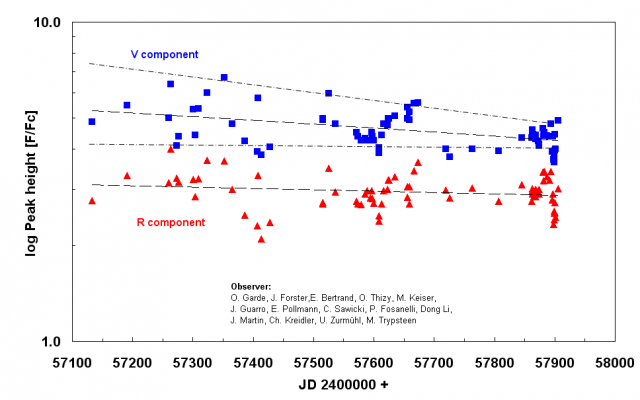
Ernst Pollmann
2 June 2017 at 7:20 pm #578266 Mr Jack MartinParticipant
Mr Jack MartinParticipantErnst,
Its rewarding to see my observations included.
More to follow.
Regards,
Jack
Essex UK
2 June 2017 at 9:44 pm #578267 MARC TRYPSTEENParticipant
MARC TRYPSTEENParticipantHi Robin,
Nice work on AZ Cas. indeed difficult area, perhaps also something for my ‘poorman” 😉 debayered DSLR, which has a reasonable QE in the blue area.
Concerning the LHiRES dispersion the native is of course approx. 0.06 Å/px as you can see in the attachment and in a 3x binning absent environment. 😉
Kind regards,
Marc.
-
AuthorPosts
- You must be logged in to reply to this topic.

